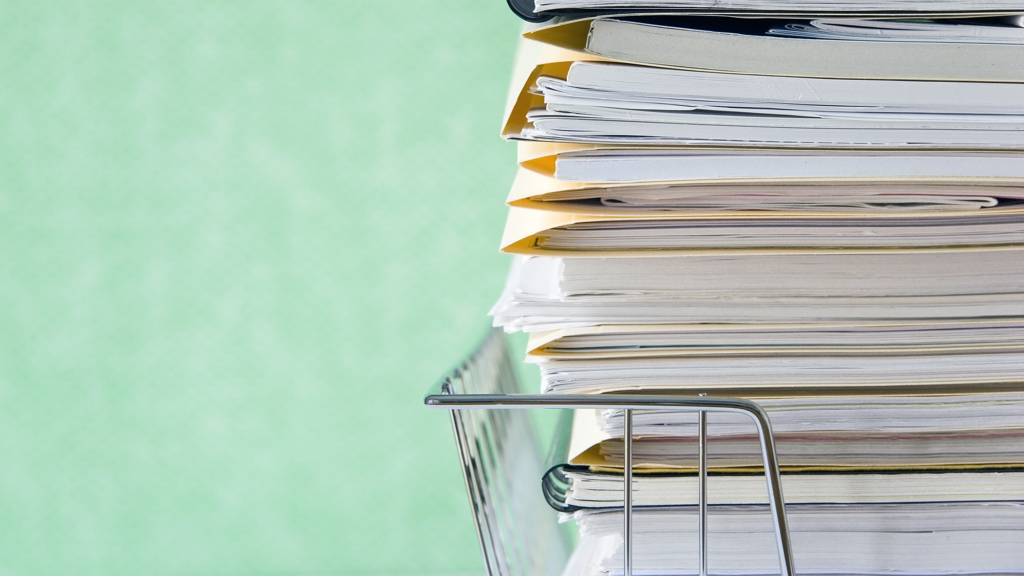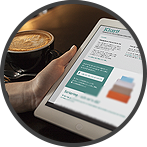Why you need a physical inbox
Datum: 2021-09-13 14:08

If you never ever handle physical papers in your work, you can stop reading this structure tip now. You can also consider yourself lucky to be part of a very small minority amongst my clients and readers.
Because even though everything is becoming increasingly digitalized, most of us still have some flow of papers and physical material.
We purchase something and get a receipt. We make notes during meetings in a notepad. We exchange business cards with someone who we are hoping will become a client. We scribble something we mustn’t forget on a piece of paper. Some suppliers still send us invoices via regular mail. Colleagues place a printed list on our desk and ask us to take a look at it and tell them what it will take to get the situation sorted. During a phone call we write down keywords and facts on a PostIt so that we will not forget what we agreed on.
So, regardless if we try to minimize it, we still have a flow of papers.
Miss fewer things
Even if you still do most of your work in a digital format, you still need a physical inbox in your office. You will then have a given place where you can put all the paper (and other physical items) which you still have not processed and addressed. And having a physical inbox will provide your colleagues with a clearly designated place to put things they want you to look at or deal with, instead of taping it to your computer screen or placing it across your computer keyboard. You will know if there is new material which you haven’t decided what to do with yet and which might contain undefined to-do-tasks which as soon as possible need to be transferred to your to-do-list so that you can set accurate priorities taking all tasks into consideration.
Only one channel in, just like in your e‑mail
If you do not have a physical inbox you might just put down whatever you have in your hand on any empty surface since ”there is space for it there”. Before you know it, you are just shuffling papers on your desk to try getting some order in the chaos, get an overview and try to somehow know what to get started on next (and you forget your to-do-list, where many of the tasks not physically present on your desk are listed).
Not having a physical inbox is like not having an e‑mail inbox, and just letting the e‑mails you receive randomly spread out on your computer desktop. If this were the case it would be virtually impossible to determine what just came from outside, and what you placed on your desktop to have it easily available. This is why it is so much better having a list (the e‑mail inbox) where the most recently received message is placed at the top, and it is very clear when you have read and processed everything (since the inbox then is empty).
An inbox is an inbox is a mailbox
But the physical inbox is not a storage-place, just as the e‑mail inbox isn’t where you should ultimately store and save your correspondence (so you should perhaps try avoiding getting an inbox that is too big and has high edges, so that you aren’t tempted to let too much remain in it). You process it in the same way as you process your e‑mail inbox, meaning that you make a decision on what something means to you and what you need to do with it, item by item (paper, booklet, note, et c). Some things end up on the to-do-list, some on the overview of greater and more extensive tasks, others are saved as reference material while waiting for you to need it.
Just as you should not store e‑mails directly in the inbox (but rather filed away in subfolders, in a subfolder-structure or in an external location), you should strive to empty this physical inbox completely once in a while as well; preferably daily, but if this is not possible, then at least once a week. But, the longer you leave it full, the more difficult and tedious it will be to process it since papers have a tendency to pile up once there is just a single one in the inbox. You see, you reluctance to putting one paper in the inbox is greater than adding that fiftieth one which doesn’t appear to make much difference.
Do this
- If you haven’t already, purchase an inbox. Or, if you would rather do something else, mark out the one surface on your desk where the newly arrived, not yet processed material lands. Outline the surface by colored and striped scotch-tape, draw, cut out and paste a helipad to you desk, write a note for your colleagues that reads ”This is where I want you to put what you are dropping off for me!”, or do something else.
- Make it your goal to empty the inbox once a week, but try to empty it daily.
- Think of a reward that you give yourself every week after successfully having achieved an empty inbox at least once. Eat a sweet, book a massage, enjoy a luxurious coffee, buy some flowers, take a nice walk or do whatever you would look forward to doing.
- When something is placed in the inbox by someone (or by yourself), try addressing it as soon as possible and create a to-do-task, put it on the project-overview, make note if it regards something you are waiting for someone else to do, throw or store away, so that you quickly can get the physical material out of the inbox. This is what I mean by ”processing”.
- When you return from a trip, empty your pockets and bag into the inbox and process every receipt, note and other material you have brought with you until the inbox again is empty.
No more piles
If you use a physical inbox to collect all incoming material, you will have fewer ”keep an eye on”-piles since you are processing the inflow of papers systematically and consciously. Fewer things will be forgotten or unintentionally neglected since you make sure that the promise you made someone is transferred into a to-do-task which is taken into account in your daily prioritizing amongst tasks. You also practice the actual ”processing” which is a great skill to have when processing your digital inbox as well.
What is your way?
How do you process the papers you cannot do anything about receiving as quickly and easily as possible? Tell me!




